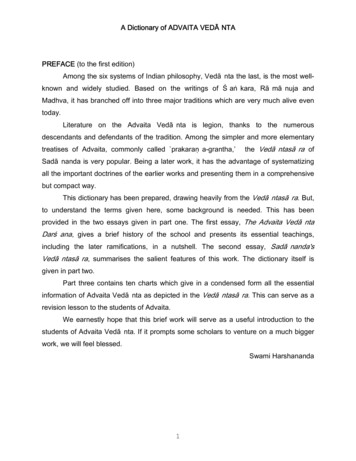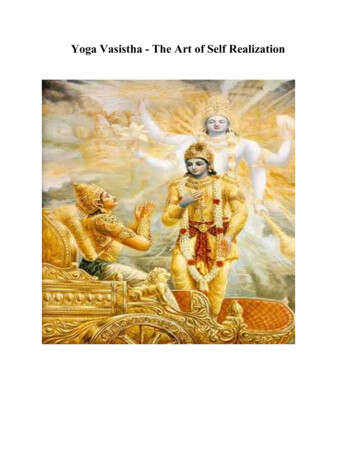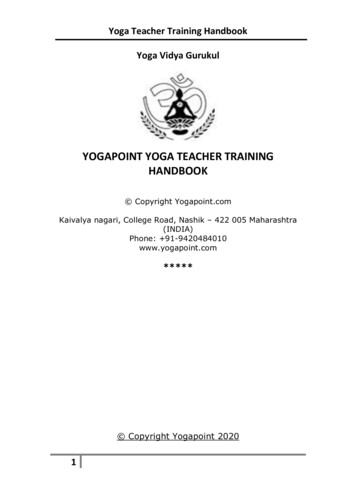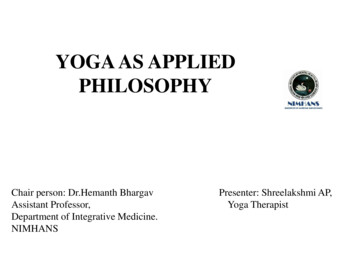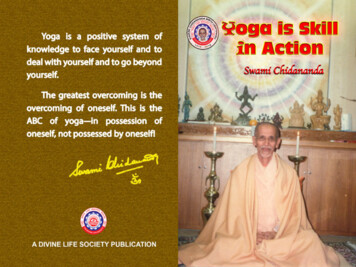
Transcription
TANTRIC ADVAITAenergizing nondualityPETER MARCHAND
TANTRIC ADVAITA – energizing nondualityCopyright 2022 Peter MarchandAll rights reserved.Independently Published by Peter Marchand - Belgium.www.leela-yoga.orgI truly do not believe in something called copyright when it comes tospirituality. Please feel free to share the teachings.Referring is always nice and useful.This book is part of a communication project on Tantric Advaita,which has been backed by numerous supportersthrough the crowdfunding platform Kickstarter.Cover image by Peter Marchand – the three colored powder drawings in theash of the ritual fireplace represent the three principal modes of energy,see Chapter 7.AumGajananam bhootganadhisevitamKapitthya jamboo phalasaara bhakshanamUmasutam shokvinashkarakamNamami vighneshwar padpankajamAum
TANTRIC ADVAITA – energizing nondualityINTRODUCTIONNonduality means ‘not-two’, an understanding which is beyondopposites, when everything is perceived as one. Through nondualawareness we can fulfill our desire for peace, which requires us towithdraw our attention from the ever-changing, restless dualities oflife. Instead, we focus on an unchanging, nondual, peaceful state ofpure being. While this pure being or impersonal awareness hasreceived many names, here we will mostly refer to it as the Self.Nonduality is originally known as Advaita, which is the centralphilosophy of all yoga and meditation. We will fully explore it in thefirst chapter of this book.The word Tantra is associated these days by most Western peoplewith a more spiritual sexuality 1, while the word basically means tochange our energy 2. Tantric Advaita is the knowledge on the nondualenergy of the Self, a major but often overlooked aspect of nonduality.Tantric Advaita is also known as the central philosophy of the ancienttradition of Tantra Yoga 3.When we think, read or hear someone talking about the Self, werather easily get a taste of that pure beingness. That taste isexperienced as a blissful feeling, which is an energy. But when thatgreat lecture is ended or the book is finished, the blissful feeling easily12Tantric sex is a rather small branch of Tantra, where sexual energy serves a spiritual purpose.Tantra from the root ‘Tanu Vistare’ means to ‘expand’ by ‘weaving’ together different energiesand the knowledge about them. See also Addendum 1 on more related terminology.3Tantra Yoga seeks the union of nondual energy and consciousness.
TANTRIC ADVAITA – energizing nondualitygets lost. And when that particular feeling of pure being is lost, purebeing itself is perceived to be lost. Tantric Advaita teaches us how tounderstand and use these changes in order to bring the uniqueenergy of the Self back and keep it.We can actually never lose the Self, as it is ever in our presence 4,yet we can definitely feel to have lost it. Thus, when the feeling of blissgets lost, we can try to bring it back by detaching from any unpleasantemotion and focus on our nondual Self-awareness. But if somehowor other we can’t do it, then Tantric Advaita offers the answers on howto find our way back to the Self by consciously changing our energy.Moreover, Tantric Advaita offers many means by which to enduringlymaintain the feeling of the Self within our energy. Tantric Advaita thusenergizes the practice of nonduality, so that we can truly enjoy life inpure beingness.For most people that try to practice nonduality, when that feelingof pure beingness seems lost, it is not because they don’t ‘get it’.Intellectually speaking, the Self can be easily understood, even bychildren. When we lose the bliss, it is also not for lack of trying to holdon to it, because oh boy do we try. The main reason why we so easilylose the feeling of pure beingness is because our energy and thus ourfeelings are naturally ever changing. Our energy even often becomesblocked in the process and when we feel stuck in an unpleasantemotion, the bliss seems very far away indeed.The way nonduality is predominantly taught these days, focusesentirely on the non-practice of maintaining nondual awareness.Teachers tend to block the seeker from using any of the otherpractices 5, which have nevertheless always been part of the ancient45More about that in Chapter 1.This pertains mostly to Western teachers, yet can also be seen to affect practitioners in India,even though the general spiritual community there knows very well the value of the ancientpractices because of their continued experiences with it.
TANTRIC ADVAITA – energizing nondualityyogic traditions. Any alternative route to the Self is generally presentedas an illusionary game of the ego, a distraction from the mostessential objective.Modern teachers of nonduality have been mostly influenced bysome great Jnana teachers 6 of the previous century, with Sri RamanaMaharishi and Nisargadatta Maharaj as the best-known examples.Their emphasis on the direct path of non-doing however addressed aparticular imbalance within the Indian culture. People were all toooften so much distracted by the more energetic practices, that themost essential practice of maintaining Self-awareness got ratherlost 7. Western nonduality teachers place the same emphasis on nondoing, maybe even with more enthusiasm, in a culture that hardlyknows any kind of practice. This logically leads to the oppositeimbalance that we are witnessing today. It leaves many practitionersof nonduality stuck into getting it without feeling it. Still some teachersseem to believe that the entire yogic tradition emerged by mistake.Please understand, I have been inspired by Nisargadatta Maharajand Ramana Maharishi for decades and I truly admire how modernnonduality teachers have promoted awareness of the Self since manyyears. It signifies the most important paradigm shift that Westernculture has been going through since ages. If I do raise questions inthis book about some of the ways in which the Self and the pathshave been presented, it is mostly to expand on the subject, letting itfurther evolve and mature. On the one hand, there are still so manywho have no idea about the Self at all and whose attention needs tobe withdrawn quite forcefully from the illusion of individuality andduality. On the other hand, there are those who have principally67Jnana Yoga is the yoga of true knowledge, see also Chapter 10.Also the Buddha and later Shankara pointed out similar imbalances, so it really is quite an oldand naturally recurring discussion. Zen Buddhism also influenced many western nondualityteachers, with a simple teaching that seems opposed to the Tantric ways of Tibetan Buddhism.
TANTRIC ADVAITA – energizing nondualityunderstood the sacred gospel of the Self and now need workableways to live nonduality as individuals. For those, Tantric Advaitaapplied as Tantric Jnana 8 is providing many practical methods.My search for the most essential Tantric Advaita teachings wasoriginally triggered by some hints found with Ramana andNisargadatta. Just like their ancient predecessor Shankara, theyunderstood Tantric Advaita quite well and promoted it to somedegree 9. In the words of Ramana himself, if awareness of the Selfseems hard to find, one may first try some breathing, some mantra, orsome other more energetic practice. And if even that does not workto sufficiently calm down, he suggests we might need a holiday. Thus,it became clear that working with consciousness and working withenergy, even in the most basic of ways, are complementary. Onepractice need not exclude the other. They can be alternated or usedsimultaneously. Awareness of the difference allows for properbalance between these two principal ways of working with the Self.While we focus our awareness on itself, we also harmonize ourenergy.Truth be told, in the wisdom gainedfrom my first and foremost teacher HarishJohari 10,therehasneverbeenanyopposition between working with energyor consciousness. The question only aroseyears after he left his body. Realizing thecomplementarityofbothapproachesmade me embark on a mission to89ill. 1. - Harish JohariTantric Jnana is the actual practice of nonduality in consciousness and energy.See Addendum 3.10I was fortunate to meet Harish Johari, a fabulous author, teacher and artist, when I was only 20years old. Until he left his body in 1999, I did not listen to any other teacher but him. More aboutDada on www.sanatansociety.org.
TANTRIC ADVAITA – energizing nondualityunderstand nonduality through Tantric Advaita with the utmostpossible clarity.As working with our energy is only truly understood by doing, Ibecame a practitioner of tantric healing about a decade ago. Thisspiritual and energetic healing practice originates with the Nepaleseshamanic tradition 11, which rests upon a foundation of Tantra Yogapracticed by the healer. These healings have been remarkably helpfulfor my students in fundamentally resolving long-standing emotionalissues, along with their physical consequences. Whatever I found tobe true in this practice, entirely confirmed the teachings of HarishJohari 12. Nevertheless, it has taken many years before I dared to putthe more intuitive awareness of the tantric mysteries that I thusacquired 13, into the rather rational words shared here.Tantric scriptures are usually relatively secretive, preferringsymbolism over reason to communicate the mysteries of nondualenergy 14. What follows is an attempt to bring the original tantricscience of nonduality in line with the typical rationality found inmodern teachings on nonduality. The most essential understandingin Tantric Advaita concerns the seeds or potentials that are hiddenwithin the Self, from which the entire universe manifests. These seedsalso offer us the principal energetic methods with which to regeneratethe feeling of nonduality and retrace our way back to the Self, whichis the central subject of this book. This includes the tantricunderstanding on how these seeds create the multiple dimensionswithin the universe, to which our individual souls remain ever11As Nepal was never durably conquered by the British, Tantra remained part of mainstreamculture, while in India it was more pushed to the fringes of society under British rule.12Even though all of Harish Johari’s books touch upon the subject of Tantra somehow, the mainreference work is ‘Tools for Tantra’, Harish Johari, Destiny Books 1988.1314See also Addendum 4.See also Addendum 2.
TANTRIC ADVAITA – energizing nondualityattached. Thus, the entirety of the yogic tradition is revealed asoriginating from the Self, bridging the illusion of a gap betweennonduality and other practices.The desire to write about Tantric Advaita largely originates frompersonal interaction with students and also the patients in my spiritualhealing practice. In the past years I have experienced a strongincrease of people who are principally depressed because theymisunderstood nondual philosophy and became stuck in their nonpractice. Both teachers and students are responsible for thisimbalance. Who doesn’t love the doctor who cures all with only onenon-pill? Yet the practitioners of yoga postures, breath, mantra, ormeditation should not be confused about whether all of that is helpfulon the spiritual path, or just some distraction produced by the ego.Such confusion is counter-productive, even if people are of courseeasily distracted.I hope that with this introduction to Tantric Advaita, I cansomewhat speed up the passing of this rather natural phase inlearning how to deal with our nonduality. Then the beauty of Selfawareness can be truly supported by the entirety of vedic, yogic andtantric science, which is exactly why it was created.Peter Marchand
TANTRIC ADVAITA – energizing nondualityNOTE ON THE USE OF SANSKRIT TERMS:To facilitate the reading for people that are less familiar withSanskrit, most of the Sanskrit terms have been translated to English,whenever a rather straightforward translation could be found. In thosecases however, the original Sanskrit term is also given as a footnotefor further reference, as well as for the readers who already knowthem.For some Sanskrit words, there is simply no clear translation inEnglish available, because the concept itself does not exist neither inthe language nor in the culture. Aside of already quite familiar wordssuch as ‘Yoga’ or ‘Karma’, only a few Sanskrit words such as ‘Gunas’or ‘Kundalini’ that seem hard to translate, are thus used within thebody of this book.As the Latin alphabet only has 26 characters, while Sanskrit has 46of them, the correct writing of Sanskrit words in the Latin alphabet isa subject of much discussion. For example, ‘Yoga’ is written ‘Yog’ inSanskrit, yet the ‘g’ used at the end of the word includes an ‘a’ whichactually sounds like the ‘u’ in ‘trust’. It’s complicated. I have mostly triedto use the characters that seem likely to lead an English readertowards the correct pronunciation.
CONTENTSp.1.Nondual Truth . .1.2. Cosmic Beingness .Nondual Energy 3.7. Identification .The Sheaths of Consciousness .9.10.3. Changing Our Energy .The Seeds Within the Self .14.16.4. Manifestation . Seed-Based Practices The Manifested Seeds .17.20.22. The Sound of Creation 23. The Mother Matter of Space The Lifeforce of Change 24.25. Generating Nondual Energy Sound 26.31. The Sound of Silence .Seed Sounds .31.33. Mantras Speech .Space .35.38.40.5.6.7. The Outer Senses .41. The Inner Senses .The Elements .44.46. Love . 54.Time . 57. The Pranic Body . 58. Nine Emotional Energies . 60.The Movement of Prana . 63.The Vibration of Prana . 66. The Storage of Prana . 72.The Polarity of Prana . . 74.
8.9.Prana & Desire . 79. The Prana of Consciousness 81.Our Soul 84. The Subconscious 86.Natural Growth . 89. The Dark Night of the Soul . 95.Feeding the Light 97. Birth & Rebirth . 99.Spiritual Dimensions . 102. Vedic Cosmology 104.Spiritual Travels & Experiences . 106. The Path of Ritual 110.10. Integral Yoga 115. Paths for the Ego . 116. The Eight Limbs . 118.Tantric Magic 120. Pitfalls of the Paths . 122.11. Keep It Simple . 126.12. Good Habits . 128. Daily Rhythm . 129. The Moon Cycle . 134.Other Natural Cycles 138. Avoidable Habits 139.13. Meditation . 140. Why Meditate?. 141.Learning How to Meditate . 142. Meditation Intention . 144.Relaxation . 146. Concentration 149.Meditation . 154. Deep Meditation . 155.14. Life . 157.ADDENDUM . 161.
ACKNOWLEDGMENTSGratitude to the Self, as without it this world would make no sense.Gratitude then also to the teachers of Self-awareness,who have guided me so compassionately.Total credit here is due to the Self, as it is to my very first teacher HarishJohari, who shaped my understanding as no other.Gratitude to life, allowing this child the time spent in auspicious writing.Gratitude to the mother and father of life.Gratitude to those who nurture the love for all three of them.Gratitude to the yogic and tantric traditions.Gratitude for the special, heartfelt support byMichael Warshaw, Rebecca Daldini and Régine Deruyver.Gratitude to the many backers from around the world that supported the‘Tantric Advaita’ project through the crowdfunding platform Kickstarter.Gratitude to these wonderful people, who provided me with inspiringfeedback on the content of some early versions :Elena Viklokova, Eric Bennewitz, Evgeny Dziatko, Michael Warshaw, PalatineGentils, Pieter Weltevrede, Rebecca Daldini, Rudy Kuhn, Schehrzade Syed,Shiv Sagar, Stephanie Rees Squibb, Sven Horn and Tanya Gordon Golad.Gratitude especially for the many hours spentin correcting the English language, aside of giving content feedback :Chander Mohini, Jan von Meppen, Jason Van Doorn, Natacha Martins,Régine Deruyver, Rich Dow and Sigurd Andersen.Any remaining errors are my own.
1NONDUAL TRUTHDualities are naturally found everywhere in the universe. Theyappear when a contrast is found between two opposites. In naturewe experience summer and winter, night and day, big and small,silence and sound, etc. Many such dualities are also found inourselves, like in thoughts and feelings, being happy or unhappy,active or inactive, male or female, peaceful or restless. All actions thatwe undertake in life are somehow meant to change the balancebetween some of these dualities. We want more of this or less of that,spend endless time thinking on how to achieve it and feel happy orunhappy depending on the results of our actions. We thus naturallylive our lives in a state of consciousness that is focused on duality.Whenever we seek peace however, it can only be found in nondual awareness, where the restless play of opposites disappears. Thenondual Self is our purest conscious beingness, which we can mostclearly experience when we stop our thinking process in meditation.Even in that absence of thoughts, we still exist and know that we exist,revealing that consciousness exists beyond thinking. And whilethinking always creates dualities, that pure existence seems beyondduality, a true oneness. While our thoughts are ever changing, theconscious witnessing that lies beyond it is experienced as neverchanging. As it holds no dualities, it cannot change.The search for the absolute truth about ourselves, the universe andeverything, has been narrowed down by yogic philosophy to thesearch for that which never changes. Whatever changes cannot be1
TANTRIC ADVAITA – energizing nondualityabsolutely true, as it appears only to disappear, like a mirage in thedesert. Only that which never changes can be seen as absolutely true,all else then being at most relatively true. As it cannot change, the Selfis seen as the absolute truth. It is who we really are, our true essence 15.Yoga means to seek the union of nonduality 16, so that everythingbecomes united as one.Any enquiry into the nature of the universe easily reveals thatwhatever we find there is ever changing. Likewise, when observingourselves we find that our body, feelings, thoughts, personality, etc.never stay the same. The only truth that never changes is then foundin our pure consciousness, which ever observes whatever happensinside and outside of us. This true beingness is experienced asremaining entirely unaffected by any of the changes that arewitnessed outside of it. It is often compared to the screen of a movietheater, which remains white independent of whatever tears or kissesappear upon it. Our pure awareness is in fact our most natural state,yet we tend to identify with what happens on the screen, forgettingthat we are the screen. As we are observing the things that happenon the screen of consciousness, we cannot be those things.This feeling of ‘I am, and I know that I am’ then is revealed as ourmost essential existence. Words fall short however when enquiringinto the very nature of this existential awareness 17. We can most easilyexplain it as not being this or that 18, but to say what it actually is,remains quite impossible. Nonduality is truly beyond words, and yetwe can still get a sense of it, while reading between the lines.15For a more detailed understanding on the subject of the Self, see also ‘The Yoga of Truth – TheAncient Path of Silent Knowledge’ by Peter Marchand, Destiny Books 2007.16Yoga refers to the root word ‘yoke’, a wooden bar one carries on both shoulders to unite andbalance two opposite objects, such as buckets.1718See also Addendum 5.Known as the practice of ‘Neti, Neti’.2
TANTRIC ADVAITA – energizing nondualityCOSMIC BEINGNESSQualities are directly related to dualities. The quality of somethingis expressed as being bigger or smaller than another thing, hotter orcolder, more or less dark, etc. When we feel the beingness of the Self,especially in deeper meditation, we cannot say that it is old or young,stupid or wise, happy or unhappy, big or small, dark or light, male orfemale, etc. It is beyond all such qualities or dualities.Qualities are what gives a particular form to anything. Having noqualities, the Self is essentially formless. It appears as a void, which ishowever not at all empty, as it is filled with conscious existence. Theformless nature of the Self is hard to grasp for our conceptual mind,which always thinks in terms of dualities, forms and qualities. Yetwhen mind is quiet, we can still sense this pure beingness existingbeyond it, while it remains hard to define it.As the Self is formless without any particular quality, it cannotchange. Only qualities are subject to change. The Self thus seemsunaffected by time. We may wonder how something can exist withoutever changing and yet here it is, appearing exactly the same last yearas it does today. This way, the Self is experienced as eternallyunchanging, unborn, unending.As the Self cannot change, there is also nothing to desire, becausewe always desire to change something. The Self is desireless and wealso cannot desire it to change. And since there is no desire, the Selfis ever at peace, just aware of what is. Whenever we are simplyenjoying ourselves sitting in the morning sun, it is desire that makesus leave that peace for something else. When we are aware of beingthe Self, we can easily move beyond desire, except maybe in thedesire for peace itself.Further observance of the Self inside of us brings the clearunderstanding that the Self is essential to everything we do. Whether3
TANTRIC ADVAITA – energizing nondualitywalking or talking, thinking or feeling, nothing that we can do ispossible without this silent witnessing happening beyond it. Wecannot even lift our hand without the Self being the observer of thatmovement. That observation of what is happening is very muchneeded in doing anything, because without it we cannot know whatwe are doing, so then how to do anything? For that reason, the Self isnamed omnipotent. The Self is not doing anything, but nothing canbe done without it. Likewise, it is omniscient, because without itnothing can be known, even if the Self never uses words 19.Since the Self is thus found wherever something is being done orknown, it must be present in everyone. Having found the Self insideof us, we then discover it to exist also in every being outside of us.Behind every eye we meet, that same witnessing must be there, for apig to do what pigs do, and also for a sunflower or a tree to follow thedirection of the sun for example. Hence, we can say that the Self isomnipresent. It exists everywhere in the universe.When comparing our Self to the Self of a pig for instance, how canwe find any difference between them? As our Self has no form and isbeyond all qualities and dualities, it cannot be seen as bigger, smarter,happier or in any way superior or inferior to that of a pig. Comparingthese two formless kinds of conscious beingness is impossible, asthere is nothing to compare them by. We might as well try to comparetwo invisible clouds. The Self appears as entirely impersonal, devoidof all individuality.Thus, we can see the Self as the Cosmic Beingness whichpervades everything, and in which all are one and the same. There isreally only one being looking out from behind a zillion eyes. Therefore,the duality between the individual and the whole is revealed as19Part of this power of knowing from the Self also comes as the ‘Cosmic Intellect’ or ‘Buddhi’,available through deep meditation and intuition, which may produce words.4
TANTRIC ADVAITA – energizing nondualityperhaps the most relevant illusion of separation 20. In essence, there isno ‘me’ as opposed to ‘us’. We are one beingness that witnesses allour various inner and outer forms, whether they are thoughts, dreams,and feelings, or physical bodies, jobs, and environments.Throughout history, the word ‘God’ has been most often used toname this Cosmic Being, yet in most people’s minds that word is moreassociated with some supreme being outside of us. As the CosmicBeingness exists both inside and outside of us, I prefer to use the word‘Self’. That Self is experienced as the illusion of the ‘individual’ Self, yetit is known to be equal to the Cosmic Self. Looking through amicroscope, the drop is not essentially different from the ocean. Theocean exists in every drop.ill. 2. – ‘Mindmap’ of the Self.That Self is who we really are 21. We are all one nondualconsciousness, formless and thus unchanging, hence true iscient,omnipotent and omnipresent, unborn cosmic beingness. Whatever20The cosmic illusion (Maya), also known as the divine play (Leela).21See also ‘The Truth of Advaita Vedanta’ on youtube.com/youyoga.5
TANTRIC ADVAITA – energizing nondualityindividuality we have is not very important compared to the Self andit is anyhow ever changing. We can rejoice in the understanding thatwe thus ever exist in peace and bliss, yet the question remains howto make this true also in our day to day feeling?The practice that is most associated with the philosophy ofnonduality is to maintain a non-doing, non-trying, non-thinking,nondual awareness. It is the practice of silencing the mind, directlyfocusing our consciousness on a nondual state of being. This is thepath of Jnana Yoga 22, where we keep an unrelenting focus on thetruth of the Self, a continued dwelling in the silent awareness of theobserver. In Tantric Advaita we come to the realization that thesuccessful application of this technique can be made easier bysimultaneously generating the feeling of nondual energy in ourselves.22Jnana Yoga is the yoga of true knowledge, see also Chapter 10.6
2NONDUAL FEELINGAll we ever really want is happiness. The search for happinessdrives all desire and action. We want more of this or less of that,hoping it will make us happier or at least allow us to remain happy.Yet at some point we understand the impermanent nature ofwhatever happiness we find in the ever-changing phenomena of life.Whatever comes has to go. We can enjoy our ice cream only until itis finished. Whomever we love now must one day die, mightotherwise leave us or become less lovable. Tired of running after akind of happiness that is always followed by unhappiness, theultimate objective of all yoga and spirituality emerges: to be happyindependent of what happens.The Self is ever beyond the duality of happiness and unhappiness,because it experiences only the never changing, peaceful happinessthat is usually referred to as bliss. Living from the nondual Self meansever living in the bliss of the Self, independent of outer circumstances.That is what we are after in yoga, so it pays to always remember thatwe are in it for the bliss. The Self is the ultimate objective of yoga,maybe not so much because it is who we truly are, but mostlybecause it gives us the permanent bliss that we really desire. If theSelf would only provide us with some empty neutral feeling, nobodywould be very interested. Contrary to what some people seem tobelieve however, the Self is not without feeling. The incredibly truesmile on our face whenever we experience the Self is full proof of thebliss that it brings.7
TANTRIC ADVAITA – energizing nondualityThe Self is originally defined in scripture as Sat-Chit-Ananda, thatBeing-Knowing-Bliss 23. The Self is the true beingness, the ultimatereality and the absolute truth (Sat) 24. The Self is also simultaneouslyexperienced as pure silent consciousness (Chit) 25. And last but notleast, the Self is also a kind of energy, a blissful feeling (Ananda) 26.That bliss is not just an attribute, but part of the very existence of theSelf 27. Tantric Advaita is the knowledge on the essential nature of thatenergy of bliss. It is the true nondual feeling, the energy of the Self.As Sat or beingness is rather self-evident as long as nondualconsciousness and energy are there, the Self is often seen as being‘composed’ of Chit and Ananda, consciousness 28 and energy 29. Yetthe Self truly exists beyond this essential duality. Consciousness andenergy may appear as opposites in manifestation, as in thinkingversus feeling. Yet, in the Self they are but two sides of the same coin,entirely inseparable. The consciousness cannot exist without theenergy, and the energy cannot be known without the consciousness.They are one beingness (Sat).Especially in modern teachings on nonduality, the Self is mostoften reduced to consciousness, awareness, the witness, theobserver, naming only one half of the pure beingness. That onlyserves the idea that the best way forward is to focus this awarenessor consciousness on itself. Thus, it excludes the energy, the Ananda,the bliss of pure beingness, because that w
Tantric sex is a rather small branch of Tantra, where sexual energyserves a spiritual purpose. 2. Tantra from the root ‘Tanu Vistare’ means to ‘expand’ by ‘weaving’ together different energies and the knowledge about them. See also Addendum 1 on more related terminology. 3. Tantr

